There are 40 different types of turtles in Mexico, and they all have their own unique features.
Whether you are an enthusiast or live in the country and want to know more about what species of turtles roam there, you’ve come to the right place.
There are tons of different kinds that you might not find in the United States!
In terms of legality, Mexico works hard to protect its sea turtles since they are decreasing in population. Keeping turtles as pets is mostly legal in the country, as long as it’s not a sea turtle.
There are some sea turtle sanctuaries in the country that strive to protect their conservation status as well as leave Mexico a safe haven for them to nest. They also bring tourism to the country.
There are many different species to choose from if you are curious as to which ones roam the country and which ones can be kept as pets.
Here are some of the awesome turtle species you can find in Mexico:
Turtles in Mexico
1. Eastern Painted Turtle

- Experience Level: Beginner
- Family: Emydidae
- Scientific Name: Chrysemys picta picta
- Common Names: Painted Turtle
- Adult Size: 4 to 10 inches
- Lifespan: 30 to 40 years
This sub-species of the Painted Turtle breed is small and easy to keep in both indoor or outdoor enclosures making them very beginner-friendly! These small, oval-shaped breeds have a flattened, smooth, dark olive or sometimes black shell with a slight height to the center of the carapace.
They’re great swimmers that will need at least 10 gallons of filtered water to themselves. They are also very easy to feed since they accept both plant and animal-based foods. They will even eat lettuce, parsley, and apples!
2. Western Pond Turtle

- Experience Level: Intermediate
- Family: Emydidae
- Scientific Name: Actinemys marmorata
- Common Names: Pacific Pond Turtle
- Adult Size: 4 to 9 inches
- Lifespan: 50 to 80 years
Western Pond Turtles are threatened for extinction and are a protected species in many states in the United States. Collection and trading of this species are illegal and unethical.
These turtles are dark-colored and have a flat shells.
Because of their status, it is best not to keep them as pets and to allow them to thrive in their natural wild habitat.
3. Mexican Mud Turtle

- Experience Level: Beginner to Intermediate
- Family: Kinosternidae
- Scientific Name: Kinosternon integrum
- Common Names: Guanajuato Mud Turtle
- Adult Size: about 6 inches
- Lifespan: 50 years
These turtles are typically dark brown or black with some cream coloration, especially on their plastron.
Mud turtles can sometimes be a little grouchy and they have sharp mouths, so you might want to try to not provoke them.
However, they are a popular choice for turtle lovers since they are relatively low-maintenance.
4. Central American River Turtle
- Experience Level: Expert
- Family: Dermatemydidae
- Scientific Name: Dermatemys mawii
- Common Names: Hickatee, Tortuga Blanca (White Turtle)
- Adult Size: about 25 inches
- Lifespan: 8 to 11 years
Not much is known about keeping these turtles in captivity.
They are very large and do not make suitable pets since they need to be in their natural river habitat.
They are harvested by humans for their meat, eggs, and shells.
They eat aquatic plants, fruits, terrestrial trees, and leaves.
5. Cuatro Ciénegas Slider

- Experience Level: Intermediate
- Family: Emydidae
- Scientific Name: Trachemys taylori
- Common Names: The Cuatro Cienegas Slider
- Adult Size: 6.6 to 8.5 inches
- Lifespan: Unknown
There isn’t much information about how to care for these turtles in captivity since they are endangered and should be left alone to live in their natural habitats.
They are typically a very dark olive green, looking almost black in color. Some individuals might have some cream or pale yellow coloration throughout their bodies.
6. Yaqui Slider

- Experience Level: Beginner to Intermediate
- Family: Emydidae
- Scientific Name: Trachemys yaquia
- Adult Size: about 10 to 16 inches
- Lifespan: anywhere between 20 to 40 years
Not a lot is known about keeping this species in captivity but seems that their care could be similar to the red-ear sliders.
They even look kind of similar except they have paler limbs and are more on the brown side with more spots. They are also larger in size.
These turtles are native to Sonora, Chihuahua, and Cajame. They can mostly be found roaming the northwest areas of Mexico.
They are listed as vulnerable by IUCN so it might be best not to keep them as pets anyways.
7. Ornate Slider

- Experience Level: Beginner
- Family: Emydidae
- Scientific Name: Trachemys ornata
- Common Names: Mexican Ornate Slider
- Adult Size: about 10 to 12 inches
- Lifespan: 50 years
These beautiful, unique sliders have patterns on their carapace that almost resemble the feathers of a peacock. These might be red with black dots or yellow.
Their bodies are typically green or olive with yellow stripes running down their neck.
These guys love to bask and are not picky eaters, making them even easier to care for.
You can find these in the wild in western Mexico at places like Jalisco, Nayarit, Guerrero, and Sinaloa.
8. Red-eared Slider
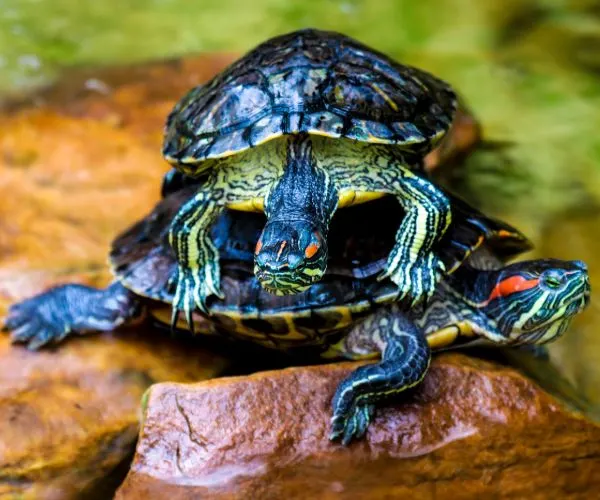
- Experience Level: Beginner
- Family: Emydidae
- Scientific Name: Trachemys scripta elegans
- Common Names: Slider Turtle, Red-eared Turtle, Red-eared Terrapin, Red-eared Slider Turtle, and Water Slider Turtle
- Adult Size: 6 to 8 inches
- Lifespan: 20 to 40 years
Fun fact time: Leonardo from the Teenaged Mutant Ninja Turtles is supposed to be a Red-eared Slider!
This aquatic turtle is a great swimmer and will need a lot of space to do so; the bigger the turtle, the bigger the tank!
They can be identified by their bright yellow stripes and a signature patch of red just behind their eyes. It is also, however, not uncommon to find some red-eared sliders without this patch.
They have webbed feet that are perfect for maneuvering around in the water. Red-eared sliders are carnivorous while young but shift to an omnivorous diet as they grow into adulthood.
When feeding your pet slider, you will want to give it a diet that is basically half vegetation with leafy greens, green beans, or carrots. You also want to feed them a 25% commercial diet, with the other quarter being animal protein.
A commercial diet will consist of turtle pellets or trout chow, whereas animal protein can be anything from live feeder fish, earthworms, aquatic snails, and crickets!
9. Coahuilan Box Turtle

- Experience Level: Beginner
- Family: Emydidae
- Scientific Name: Terrapene coahuila
- Common Names: Aquatic Box Turtle
- Adult Size: around 9 inches
- Lifespan: 60 to 65 years
This smaller aquatic turtle looks almost completely black but is actually dark brown or dark grey with some lighter colored areas which might be tan or pale green in some individuals. Some might even be more tan than black.
The high salinity of the water gives these turtles a light, almost white shell in appearance.
They are critically endangered and are listed in the top 25 most endangered species on Earth.
10. Spotted Box Turtle

- Experience Level: Beginner
- Family: Emydidae
- Scientific Name: Terrapene nelsoni
- Adult Size: 5 to 6 inches
- Lifespan: 50 to 100 years
These high-domed turtles are typically light to dark brown or black with white, tan, or yellow spots dotted along their carapace. These spots might also be on their limbs and head.
This species can be found scattered around northwestern Mexico in places like Sonora, Nayarit, and Sinaloa. They may also be found in Chihuahua and Jalisco.
11. Yellow Mud Turtle

- Experience Level: Beginner
- Family: Kinosternidae
- Scientific Name: Kinosternon flavescens
- Common Names: Yellow-necked Mud Turtle
- Adult Size: around 6 inches
- Lifespan: 40 years
These species are endemic to Mexico but are also native to the Central United States.
They are very cool-looking, somewhat domed turtles with cream to yellow-colored, sometimes olive, carapace that has darker-colored seams etched into their backs.
The plastron is darker brown and their limbs and head are grey-olive or dark with a cream neck.
These are pretty low-maintenance turtles, making them suitable for beginner turtle keepers.
12. Oaxaca Mud Turtle

- Experience Level: Beginner
- Family: Kinosternidae
- Scientific Name: Kinosternon oaxacae
- Adult Size: 5 to 6 inches
- Lifespan: Unknown
Not much is known about the demographics of Oaxaca Mud Turtles in general, let alone what they need to thrive in captivity. While they are somewhat similar to Yellow Mud Turtles, they might not have the exact same needs.
They are the least known turtle species in Mexico.
Their name comes from their native Mexican state of Oaxaca.
13. Baja California Slider

- Experience Level: Not Recommended
- Family: Emydidae
- Scientific Name: Trachemys nebulosa
- Common Names: Black-bellied Slider
- Adult Size: 6 to 14.5 inches long
- Lifespan: 20 to 40 years
These turtles are not recommended as pets since they are super high-maintenance and will need more space than any suitable house pet would.
They are native to Baja, California, but can also be found in Sonora and Sinaloa, Mexico.
They are not popularly kept as pets but can still be found by dedicated breeders.
14. Alamos Mud Turtle

- Experience Level: Unknown
- Family: Kinosternidae
- Scientific Name: Kinosternon alamosae
- Adult Size: 3.5 to 4.7 inches
- Lifespan: Unknown
These turtles are mostly found in temporary shallow pond habitats like roadside ditches or arroyos.
Not much is known about these turtles, especially how to care for them in captivity but they are endemic to Mexico.
They are not popularly kept as pets but can still be found by dedicated breeders.
15. Durango Mud Turtle
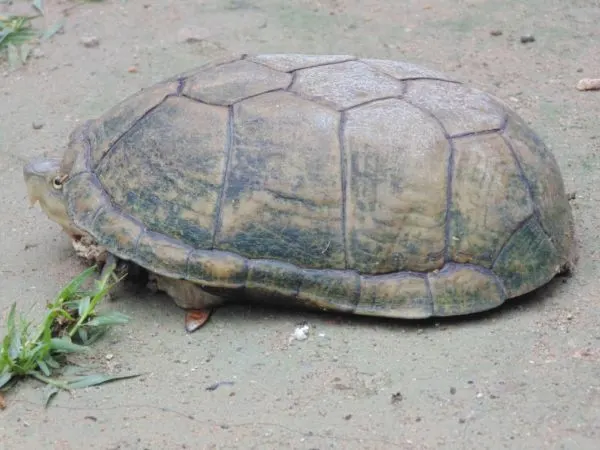
- Experience Level: Unknown
- Family: Kinosternidae
- Scientific Name: Kinosternon durangoense
These guys are similar to musk turtles and like to live in freshwater habitats such as quiet rivers and swamps.
They can be found in north-eastern Mexico in states like Coahuila, Chihuahua, and of course, Durango.
They are not popularly kept as pets but can still be found by dedicated breeders.
16. Mexican Spotted Wood Turtle

- Experience Level: Intermediate
- Family: Geoemydidae
- Scientific Name: Rhinoclemmys rubida
- Common Names: Mexican Spotted Terrapin
- Adult Size: 6 to 9 inches
- Lifespan: 12 years
These turtles are red with small, paler spotting on their carapace. They may overhead easily, which can be fatal to them so you need to make sure you provide them with cooler shady areas as well as a basking point.
There is not much known about how to keep this species in captivity but we do know that they are listed as near threatened for extinction according to the IUCN.
They are not popularly kept as pets but can still be found by dedicated breeders.
17. Herrera’s Mud Turtle

- Experience Level: Beginner to Intermediate
- Family: Kinosternidae
- Scientific Name: Kinosternon herrerai
- Adult Size: 4.5 to 5.2 inches
- Lifespan: 15 to 19 years
These turtles are native to Mexico and are typically olive green, cream, or red in some individuals. They have large, dark seams in their carapace.
They are not popularly kept as pets but can still be found by dedicated breeders.
18. Rio Grande Cooter

- Experience Level: Beginner
- Family: Emydidae
- Scientific Name: Pseudemys gorzugi
- Adult Size: 7 to 15 inches
- Lifespan: 15 to 30 years
They are native to northeastern Mexico, but can also be found in the adjacent southwestern United States.
The Rio Grande Cooter has an olive carapace with alternating blots of yellow and black. Their skin is olive green or brown with yellow stripes running throughout their neck, limbs, and tail.
They are not popularly kept as pets but can still be found by dedicated breeders.
19. Big Bend Slider

- Experience Level: Beginner
- Family: Emydidae
- Scientific Name: Trachemys gaigeae
- Common Names: Mexican Plateau Slider
- Adult Size: 12 inches
- Lifespan: 15 years
This aquatic turtle can only be found in the desert riverines of Northern Mexico as well as the Southwestern States of the United States.
These beautiful sliders are typically an olive or green color with yellow stripes throughout their head and limbs. They have a flatter carapace and a dark orange or almost red marking on each side of their head.
20. Cuatro Cienegas Softshell

- Experience Level: Intermediate
- Family: Trionychidae
- Scientific Name: Apalone spinifera atra
- Common Names: Black Spiny Softshell
- Adult Size: 10 inches
- Lifespan: 50 years
These guys are typically green-grey or light olive with a white appearance on their carapace due to the high salinity levels of the water they inhabit. Their shells are soft, rounded, and easily bendable under pressure, which is why they are called Softshells.
While they are manageable as pets, you will need to make sure to keep the water super clean and keep their tank free of sharp objects since it can puncture their unprotected, soft bodies.
21. Common Box Turtle

- Experience Level: Beginner
- Family: Emydidae
- Scientific Name: Terrapene Carolina
- Common Names: Woodland Box Turtle
- Adult Size: 5 to 8 inches
- Lifespan: 25 to 35 years
Box turtles get their names from their highly-domed, rounded shells which are typically dark brown. They also have orange or yellow markings that distinguish them from other turtles!
These omnivorous turtles will eat almost anything from berries, roots, and flowers to insects, eggs, and amphibians. Pretty much whatever they can get their mouths on in their natural habitat of streams and ponds!
The minimum size of their enclosure should be a 75-gallon tank, although they will thrive better in an outdoor area. They will need both sunny places to bask and shady places to hide.
Box turtles are land turtles and like to roam around but also love to burrow so you will need to find some sort of bedding that they can use for comfort! It can be either paper-based or natural bedding like straw, alfalfa pellets, or hay.
Although, you should make sure your box turtle also has constant access to water for soaking as well as drinking. It’s important that it is still shallow enough for them to climb out of and large enough for them to soak in.
22. Rough-footed Mud Turtle

- Experience Level: Beginner to Intermediate
- Family: Kinosternidae
- Scientific Name: Kinosternon hirtipes
- Common Names: Mexican Mud Turtle, Big Bend Mud Turtle, Mexican Plateau Mud Turtle; Casquito de Pata Rugosa, Chihuahuan Mud Turtle
- Adult Size: about 6 inches
- Lifespan: 50 years
The species of mud turtle is endemic only to the southwestern United States as well as northern Mexico.
These turtles are typically dark brown, dark olive, or black with some cream coloration, especially on their plastron. They also have darker-colored seams throughout their carapace.
Mud turtles can sometimes be a little grouchy and they have sharp mouths, so you might want to try your best not to provoke them.
However, they are a popular choice for turtle lovers since they are relatively low-maintenance.
23. Jalisco Mud Turtle

- Experience Level: Beginner to Intermediate
- Family: Kinosternidae
- Scientific Name: Kinosternon chimalhuaca
- Adult Size: about 6 inches
- Lifespan: 50 years
The species of mud turtle is endemic to Colima and Jalisco, of course, as you can see from their name.
These turtles are typically dark brown, dark olive, or black with some red coloration, dark olive-grey limbs or head, and a cream or yellow underside. They also have darker-colored seams throughout their carapace.
Mud turtles can sometimes be a little grouchy and they have sharp mouths, so you might want to try your best not to provoke them.
However, they are a popular choice for turtle lovers since they are relatively low-maintenance.
24. Tabasco Mud Turtle

- Experience Level: Beginner to Intermediate
- Family: Kinosternidae
- Scientific Name: Kinosternon acutum
- Common Names: Pochitoque
- Adult Size: 4 to 5 inches
- Lifespan: 45 to 50 years
This species of Mud Turtles be found in central Tabasco, Veracruz, northern Guatemala, and Belize. They like to inhabit smaller streams, marshes, and ponds.
Mud turtles can sometimes be a little grouchy and they have sharp mouths, so you might want to try your best not to provoke them.
However, they are a popular choice for turtle lovers since they are relatively low-maintenance.
25. Mexican Giant Musk Turtle

- Experience Level: Intermediate to Expert
- Family: Kinosternidae
- Scientific Name: Claudius angustatus
- Common Names: Narrow-bridged Musk Turtle, Giant Musk Turtle, Stinkpot
- Adult Size: 4 to 6.5 inches
- Lifespan: 16 years
This interesting species of turtle is endemic to Central America and Mexico.
They are typically grey with cream yellow-colored lining and coloration around their bodies, depending on the individual. This coloration can be both on their carapace and bodies.
These turtles are fast growers and will need lots of space to roam around.
They have very strong jaws with pointed beaks and they aren’t afraid to use them. They look pretty vicious like they could bite your finger off as well, but are also quite cute.
While they can be a little more difficult to maintain as a pet since they require specific foods and a lot of space, they can make really awesome pets.
26. Scorpion Mud Turtle

- Experience Level: Beginner to Intermediate
- Family: Kinosternidae
- Scientific Name: Kinosternon scorpioides
- Adult Size: 3.6 to 10.6 inches
- Lifespan: 45 years
How each individual of this species looks will vary based on geography, but they can be brown, tan, olive, or black with red, orange, or yellow colorations. Their carapace is oval-shaped and domed.
They are highly aquatic and adaptable to all kinds of bodies of water. They can be found in both Central and South America.
Of course, they are native to Mexico.
They are cannibalistic and will bite off the toes and limbs of anyone near so you will want to be super careful with these guys. They have sharp mouths, so you might want to try your best not to provoke them.
However, they are a popular choice for turtle lovers since they are attractive and awesome to look at.
27. Meso-American Slider

- Experience Level: Beginner to Intermediate
- Family: Emydidae
- Scientific Name: Trachemys venusta
- Common Names: Meso American Sliders
- Adult Size: about 12 to 20 inches (depending on sex)
- Lifespan: 30 to 40 years
These cool-looking sliders have yellow circular patterns on their carapace as well as yellow stripes running down their neck. Their bodies are typically green or olive in color.
You can find this species in the wild distributed from Mexico to Colombia.
28. Creaser’s Mud Turtle

- Experience Level: Beginner to Intermediate
- Family: Kinosternidae
- Scientific Name: Kinosternon creaseri
- Adult Size: Unknown
- Lifespan: Unknown
Not much is known about this species in captivity but they are native to the Yucatán Peninsula in southeastern Mexico.
29. Furrowed Wood Turtle

- Experience Level: Intermediate
- Family: Geoemydidae
- Scientific Name: Rhinoclemmys areolata
- Common Names:
- Adult Size: 6 to 8 inches
- Lifespan: 20 to 30 years
These turtles typically look a little longer in the limbs than other turtles.
Their carapace is typically dark grey, olive, or brown in color with yellow, orange, or red colorations along the inner areas of their shell. Their plastron is typically dark brown or black with cream-colored edges.
They are native to the Yucatán Peninsula and adjacent areas of Central America.
30. Mexican Snapping Turtle

- Experience Level: Intermediate to Expert
- Family: Chelydridae
- Scientific Name: Chelydra rossignonii
- Common Names: Central American Snapping Turtle, Yucatan Snapping Turtle
- Adult Size: up to 28 inches
- Lifespan: 20 to 25 years
Due to this species size and “snappy” demeanor, they can be quite hard to keep.
They like open, murky, highly vegetated waters and are native to Mexico, Belize, Guatemala, and Honduras.
They have a larger head, a long tail, a beak-like pointed mouth, and a coarse carapace with algae growth, helping them camouflage against their surroundings.
They can be brown, olive, or black in color with a tan, grey, or yellow plastron.
31. Sonora Mud Turtle

- Experience Level: Beginner to Intermediate
- Family: Kinosternidae
- Scientific Name: Kinosternon sonoriense
- Common Names: Sonoyta Mud Turtle
- Adult Size: 8.5 inches
- Lifespan: 6 to 10 years
These guys have a smooth, slightly domed carapace and are typically brown or olive green in color. Their bodies are typically dark grey and their eyes are an interesting yellow.
They can be found in both Mexico and the United States.
Mud turtles can sometimes be a little grouchy and they have sharp mouths, so you might want to try your best not to provoke them.
32. Arizona Mud Turtle

- Experience Level: Beginner to Intermediate
- Family: Kinosternidae
- Scientific Name: Kinosternon flavescens arizonense
- Adult Size: 4 to 7.5 inches
- Lifespan: 6 to 10 years
These semi-aquatic turtles can be found in the rivers and lakes of both Sonora and in the Desert of Arizona.
They have oval-shaped, brown carapaces with the same colored limbs and a cream underside.
33. Vallarta Mud Turtle

- Experience Level: Beginner to Intermediate
- Family: Kinosternidae
- Scientific Name: Kinosternon vogti
- Adult Size: less than 4 inches
- Lifespan: Unknown
This distinctive little turtle is only endemic in the state of Jalisco, Mexico. They only exist in small man-made ponds or streams found in Puerto Vallarta.
They are one of the most threatened species of freshwater turtles.
They have an olive-brown, grey, or almost black shell with a grey head and a white patch on their forehead. Their chin is also white and might have some slight markings or striping on it.
Sea Turtles in Mexico
Here are some sea turtles you might find in Mexico:
34. Galápagos Green Turtle

- Scientific Name: Chelonia agassizii
- Family: Dermochelyidae
- Adult Size: up to 5 feet
- Weight: 694 pounds
- Lifespan: p to 60 years
- Conservation Status: Vulnerable – Population decreasing
- Habitat: They like both tropical and sub-tropical waters anywhere around the Pacific islands
- Clutch Size: 2 to 25 eggs
- Food: Herbivorous; seagrass and algae
- Appearance: Slightly domed, green or brown carapace and a cream underside.
35. Green Sea Turtle

- Scientific Name: Chelonia Mydas
- Family: Cheloniidae
- Adult Size: 3 to 4 feet
- Weight: 300 to 400 pounds
- Lifespan: 80 to 100 years
- Conservation Status: Endangered
- Habitat: Tropical and subtropical waters in bays and shores by the coastline; anywhere with seagrass beds
- Clutch Size: 110 to 115 eggs; Nesting 2 to 5 times per season
- Food: Primarily herbivorous, eating seagrass and seaweed, sometimes algae. Sometimes younger green sea turtles will feed on worms, aquatic insects, or small crustaceans.
- Appearance: They have nonretractable, small heads and a heart-shaped, brown carapace. They will wear a greenish hue on their scaley skin, will have a cream-colored underside, and beady eyes.
36. Hawksbill Sea Turtle
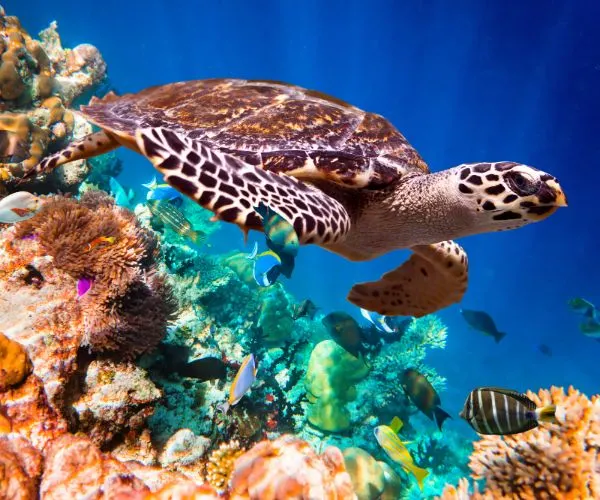
- Scientific Name: Eretmochelys Imbricata
- Family: Cheloniidae
- Adult Size: 30 to 35 inches
- Weight: between 100 to 155 pounds
- Lifespan: About 30 to 50 years
- Conservation Status: Critically Endangered
- Habitat: Tropical, rocky waters, mangroves, lagoons, or near tropical coral reefs.
- Clutch Size: Anything from 140 to 200 eggs; Nesting about 4 times each season or every 2 weeks
- Food: Omnivorous; They will feed on sea urchins, jellyfish, mollusks, marine algae, and sponges!
- Appearance: They get their name from their unique beak-like mouths, which are similar to hawks. They will show off an elongated, oval-shaped, amber-colored, shell that has unique patterns on it. Their also amber flippers have claws at the “elbows” of them as well!
37. Kemp’s Ridley Sea Turtle

- Scientific Name: Lepidochelys Kempii
- Family: Cheloniidae
- Adult Size: About 25 inches
- Weight: 77 to 100 pounds
- Lifespan: 30 years
- Conservation Status: Critically endangered
- Habitat: Shallow muddy or sandy coastal lines
- Clutch Size: 100 to 110 eggs; nesting 2 to 3 times per season
- Food: They love crabs, especially blue crabs, but will also eat shrimps, clams, and mussels
- Appearance: Triangular head with a slightly hooked beak, greyish-green, circular carapace with a light yellow or cream plastron. Their undersides may also be a pale yellow to cream color.
38. Leatherback Sea Turtle

- Scientific Name: Dermochelys Coriacea
- Family: Dermochelyidea
- Adult Size: About 6 to 7 feet
- Weight: Between 1200 and 1450 pounds
- Lifespan: 30 years
- Conservation Status: Vulnerable
- Habitat: They like warm waters and can be found in every ocean except the Arctic. They will inhabit calm, shallow lagoons or bays. They love to nest on sand, sloping beaches with good vegetation.
- Clutch Size: 100 to 110 eggs.
- Food: Mainly jellyfish but sometimes some fish and other marine creatures.
- Appearance: It is the only sea turtle that lacks a hard shell, which is dark grey to black in color, sometimes showcasing scattered white spots or blotches. Their dark carapace is elongated and flexible with long ridges running down its length.
39. Loggerhead Sea Turtle
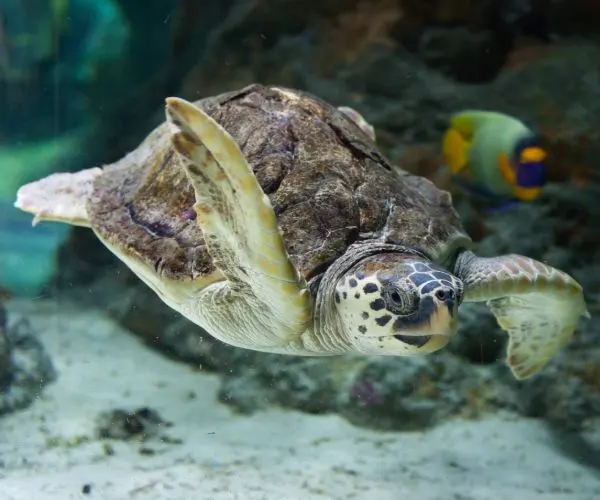
- Scientific Name: Caretta caretta
- Family: Cheloniidae
- Adult Size: between 35 inches and 3 feet
- Weight: 154 pounds
- Lifespan: 70 to 80 years
- Conservation Status: Endangered
- Habitat: Shallow, subtropical coastal regions
- Clutch Size: 100 to 125 eggs; nesting 4 to 5 times per season
- Food: Carnivorous; they will eat clams, conches, and crabs!
- Appearance: Hard-shelled turtles with a reddish-brown color, a yellow underbelly, and long flippers. They have a large head with a defined jaw.
40. Olive Ridley Sea Turtle
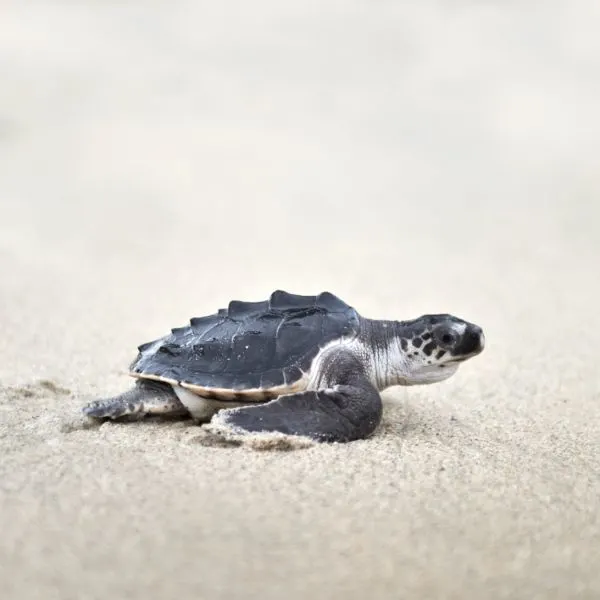
- Scientific Name: Lepidochelys olivacea
- Family: Cheloniidae
- Adult Size: 2 feet
- Weight: up to 100 pounds
- Lifespan: 50 years
- Conservation Status: Vulnerable
- Habitat: Open-ocean, warm waters. Scattered across thePacific, Atlantic, and Indian oceans.
- Clutch Size: 110 eggs
- Food: Omnivorous;Fish, shrimp, mollusks, tunicates, lobster, crabs, and algae.
- Appearance: Grey-olive green with a heart-shaped carapace and one or two claws.
Conclusion
Mexico definitely has a wide range of different species of turtles for enthusiasts to check out. All the different kinds of mud turtles, musk turtles, snapping turtles, and more Mexico-exclusive species.
We hope that this article helped you identify all the different kinds of turtles you can find in the country.
Leave us a question or comment down below letting us know if we missed anything or sharing your experiences with turtles in Mexico.
Other nearby states
- Turtles in Arizona
- Turtles in California
- Turtles in Costa Rica
- Turltes in the Galapagos Islands
- Turtles in Hawaii
- Turtles in New Mexico
- Turtles in Texas
